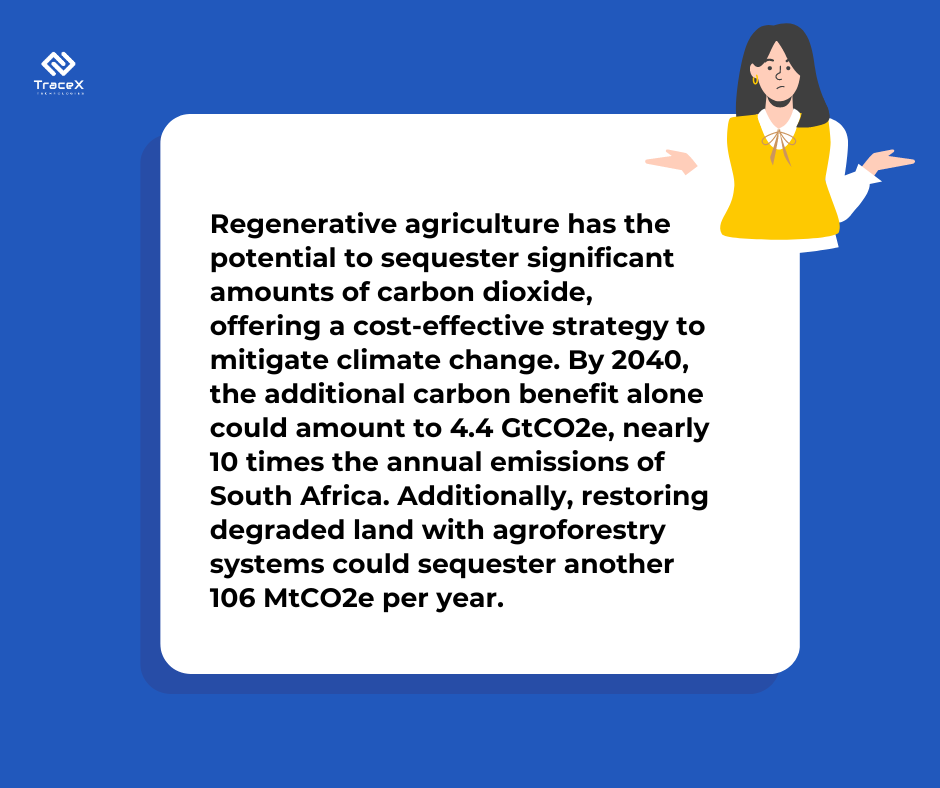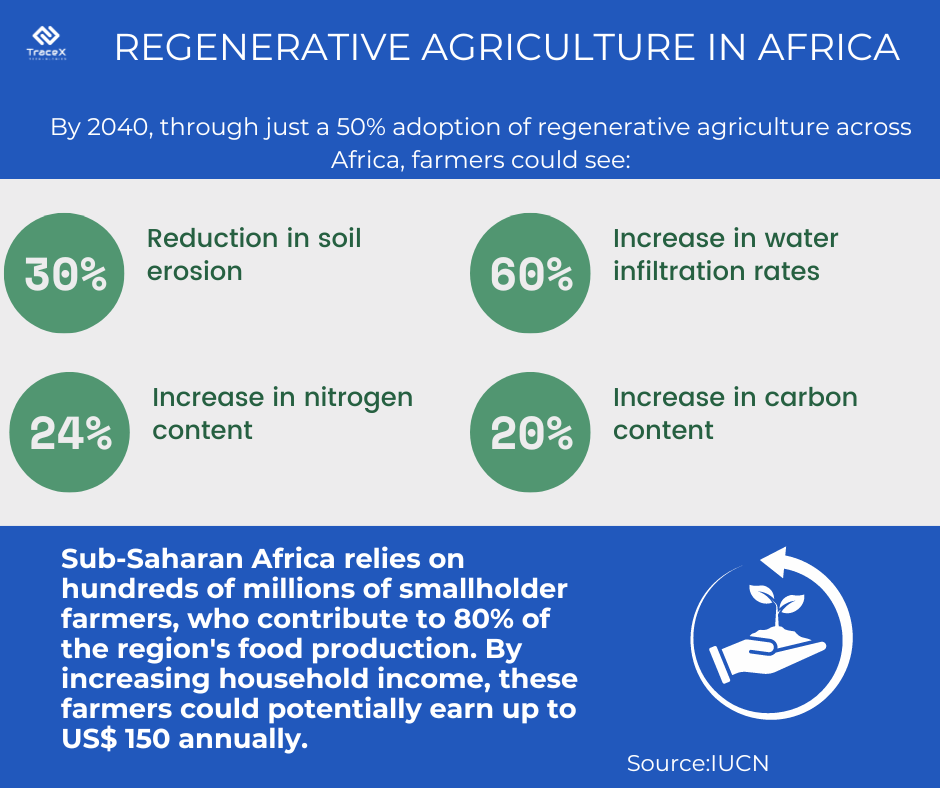Contact: +91 99725 24322 |
Menu
Menu
Quick summary: Unlocking the potential of regenerative agriculture in Africa: Explore innovative practices, sustainable solutions, and the impact on food security and environmental conservation.

Regenerative agriculture in Africa is emerging as a transformative approach to farming that not only seeks to sustainably meet the continent’s food needs but also restore and enhance the health of its ecosystems. By prioritizing soil health, biodiversity, and ecosystem resilience, regenerative agriculture offers a promising alternative to conventional farming methods that often degrade natural resources and contribute to environmental degradation.
Regenerative agriculture is a farming technique that focuses on repairing and improving ecosystem health while also increasing agricultural productivity. It includes measures like minimal soil disturbance, crop rotation, cover cropping, and holistic land management.
In Africa, regenerative agriculture is extremely important because of its ability to address the continent’s critical environmental, social, and economic concerns. Regenerative agriculture, with its emphasis on soil health restoration, water conservation, and biodiversity improvement, provides solutions to the continent’s widespread soil degradation, erosion, biodiversity loss, water scarcity, and desertification. Furthermore, by promoting sustainable agricultural techniques and empowering local people, regenerative agriculture may help to poverty alleviation, food security, and climate resilience, making it a crucial road towards sustainable development in Africa.
Soil degradation and erosion are common problems in African agriculture, exacerbated by unsustainable farming practices such monocropping, overgrazing, and deforestation.
These methods deplete the soil of important nutrients, resulting in decreased fertility, greater susceptibility to erosion, and lower agricultural yields. Soil erosion not only reduces agricultural output, but it also adds to sedimentation in water bodies, jeopardising water quality and aquatic habitats.
The loss of biodiversity presents another serious threat to African agriculture. Intensive agricultural methods sometimes prioritise a few high-yield crop types or livestock breeds, displacing indigenous species and reducing genetic diversity. This loss of biodiversity weakens ecosystems, reduces pest and disease resistance, and reduces agricultural system stability and output.
Water scarcity and desertification increase agricultural problems in Africa. Climate change, deforestation, and poor water management methods all contribute to declining water supplies and expanding desert areas. Water shortage stifles agricultural output exacerbates food insecurity, and fuels conflict over depleting water supplies, posing serious challenges to livelihoods and socioeconomic stability across the continent.
In Africa, traditional farming techniques can perpetuate poverty and worsen food insecurity. Smallholder farmers, who account for a sizable proportion of the population, face barriers to accessing resources and inputs, resulting in low production and income. Furthermore, relying on cash crops for export markets might jeopardise food sovereignty, making communities exposed to global commodity price volatility and repeating cycles of poverty and hunger.
Land degradation caused by conventional farming methods adds to the relocation of indigenous groups and exacerbates socioeconomic issues. Large-scale agriculture, deforestation, and land grabbing frequently encroach on traditional territories, resulting in the loss of livelihoods, cultural heritage, and social cohesiveness for indigenous communities. This displacement further isolates already vulnerable populations, worsening poverty and socioeconomic inequities.
Furthermore, the use of chemical inputs like pesticides and synthetic fertilisers endangers farmers, farmworkers, and the people around them. Toxic substances can cause immediate and chronic health problems, such as respiratory ailments, reproductive issues, and cancer. These health hazards disproportionately affect marginalised communities, perpetuating poverty cycles and exacerbating social and economic disparities throughout African cultures.
Learn how innovative practices are reshaping farming for a greener, more resilient future.
Explore the future of sustainable agriculture land management.
Regenerative agriculture is a comprehensive strategy to tackling environmental issues and increasing agricultural productivity. Embracing high-yielding, resilient, and adaptive practices (HYRAP) is the cornerstone of an African-centric approach to climate-smart agriculture. These practices prioritize productivity to ensure food security and enhance livelihoods. They are resilient, offering diversity to withstand and recover from the inevitable effects of climate change. Moreover, they are adaptive, recognizing the need to navigate increasingly unpredictable weather patterns, crucial for a continent heavily reliant on rainfall rather than irrigation.

More farmers are embracing no-till and low-till practices, directly sowing crops into minimally cultivated soil or leaving it uncultivated since the last harvest. Additionally, some integrate crop residue as mulch.
According to UNFCC, around 30% of South African farmers employ this soil management approach.
Water harvesting and irrigation represent effective methods to decrease dependency on rainfall, yet their utilization remains significantly underexplored, with only approximately 5% of agricultural land in Africa being irrigated. A rising trend is the adoption of solar-powered irrigation systems, offering predictable water delivery and circumventing the environmental drawbacks associated with conventional petrochemical-powered systems.
Crop rotation is a well-established agricultural practice involving the sequential cultivation of diverse crops on the same land to maintain soil fertility and mitigate pest and disease pressure. An exemplary method involves alternating legumes like beans with maize, a technique embraced by farmers across Africa for generations. This approach is rooted in the understanding that crop rotation enhances soil health, diminishes pest and disease incidence, boosts crop productivity, and diminishes the need for pesticides. Additionally, intercropping, the concurrent cultivation of multiple crops, enhances on-farm biodiversity, soil health, and reduces reliance on single crops.
Various strategies are employed to manage pests in agriculture. In Kenya, for instance, pheromone traps have been deployed to address fruit fly infestations in mango orchards. Similarly, adjustments to irrigation practices have been implemented in other countries to mitigate pest issues, such as moderating water usage to minimize the risk of root diseases and weed proliferation.
Agroforestry, integrating tree cultivation, is currently practiced in Kenya and Zambia and is gaining momentum throughout Africa, including initiatives like the Grand African Savannah Green Up.
Another prevalent strategy involves cultivating drought- and heat-tolerant crops to sustain food and biomass production during dry spells. Fonio millet, one of Africa’s oldest cultivated cereal crops, thrives in various regions of Western Africa, including Senegal, Mali, Burkina Faso, Nigeria, and Chad. This resilient grain grows rapidly and is highly resistant to drought. Not only is it more nutrient-rich than alternative grains like wheat, but it also serves as a valuable source of fodder for livestock, in addition to being a staple food for human consumption.
The integration of technology is critical to promoting regenerative agriculture methods in Africa. Farmers can use digital monitoring and data collecting equipment to get real-time information about soil health, weather trends, and crop performance. These tools, which include smartphone apps and sensor-based devices, enable farmers to make more informed decisions, optimise resource allocation, and increase agricultural productivity while reducing environmental impact.
Precision agriculture techniques improve resource efficiency and productivity by carefully controlling inputs like water, fertiliser, and herbicides. Farmers can utilise satellite photos, drones, and GPS technology to apply inputs more accurately, monitor crop health, and find areas for improvement. This targeted method minimises waste, lowers environmental pollution, and increases yields, making farming operations more sustainable and profitable.
Blockchain technology represents a possible alternative for improving traceability and transparency in agricultural supply networks. Blockchain allows stakeholders to follow agricultural products from farm to fork by providing a secure and immutable record of transactions. This transparency increases consumer trust, promotes fair trading practices, and ensures the authenticity and quality of agricultural products. Furthermore, blockchain can empower smallholder farmers by giving them access to global markets, fair prices for their produce, and better lives, fostering inclusive and sustainable development in Africa.
TraceX’s farm management solutions and digital MRV platform serve as invaluable tools for farmers looking to embrace regenerative agriculture. By providing data-driven insights, facilitating sustainable practices, and ensuring transparency, TraceX empowers farmers to cultivate healthier, more resilient landscapes while contributing to environmental conservation and long-term agricultural sustainability.
TraceX provides farmers with tools to monitor various aspects of their farms, including soil health, crop performance, and biodiversity. By gathering real-time data and generating comprehensive reports, farmers gain valuable insights into the effectiveness of their regenerative practices.
The digital MRV platform allows farmers to collect and analyze data on soil health, water usage, and carbon sequestration, among other key metrics. By harnessing this data, farmers can identify areas for improvement and implement regenerative practices that maximize productivity while minimizing environmental impact.
By leveraging blockchain technology, TraceX enables transparent and traceable documentation of farming activities. This ensures accountability throughout the supply chain, from farm to market, and builds trust among consumers and stakeholders.
Regenerative agriculture has enormous promise for tackling major difficulties in Africa while also providing numerous benefits for food security, climate resilience, and rural development. Regenerative techniques boost agricultural output and resilience to climate change by improving soil health, increasing water retention, and boosting biodiversity.
Diversified agricultural systems and integrated livestock management not only promote food security by providing various and nutritious food sources, but they also increase farmers’ revenue streams, lowering their exposure to economic shocks.
Furthermore, regenerative agriculture promotes rural development by revitalising local economies, creating new job possibilities, and improving community resilience. Regenerative agriculture, via sustainable land management practices, helps conserve natural resources, safeguard ecosystems, and mitigate the negative effects of climate change on vulnerable populations.

Agroecological concepts, agroforestry systems, and holistic land management approaches are examples of emerging trends and advances in regenerative agriculture. Furthermore, advances in digital technology, such as remote sensing, artificial intelligence, and blockchain, are rapidly being used to improve monitoring, data collecting, and traceability in regenerative supply chains. These innovations have the potential to improve the scalability, effectiveness, and impact of Africa’s regenerative agriculture projects, resulting in a more sustainable and resilient food system for future generations.
Finally, regenerative agriculture is a transformative approach to solving Africa’s complex agricultural difficulties while generating significant benefits for food security, climate resilience, and rural development. Regenerative methods, which improve soil health, conserve water, and promote biodiversity, provide avenues to greater agricultural productivity and resilience in the face of climate change.
Furthermore, regenerative agriculture has enormous potential to promote rural development by revitalising local economies, increasing job opportunities, and strengthening community resilience.
